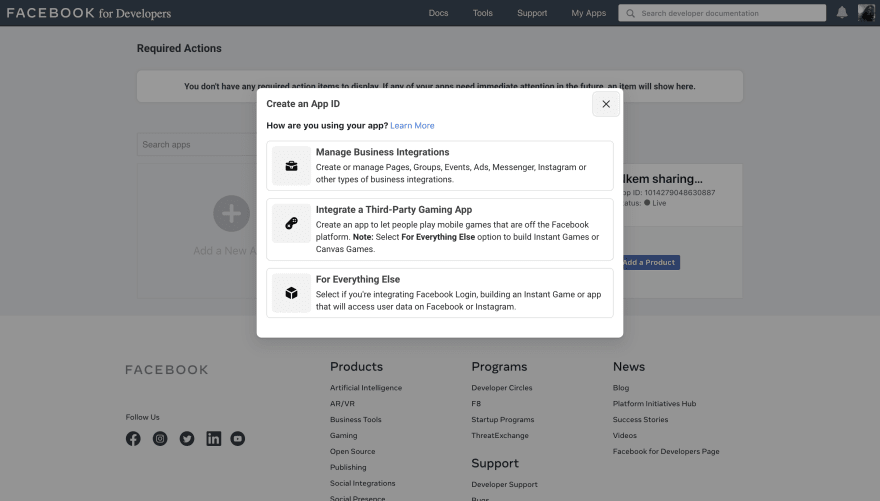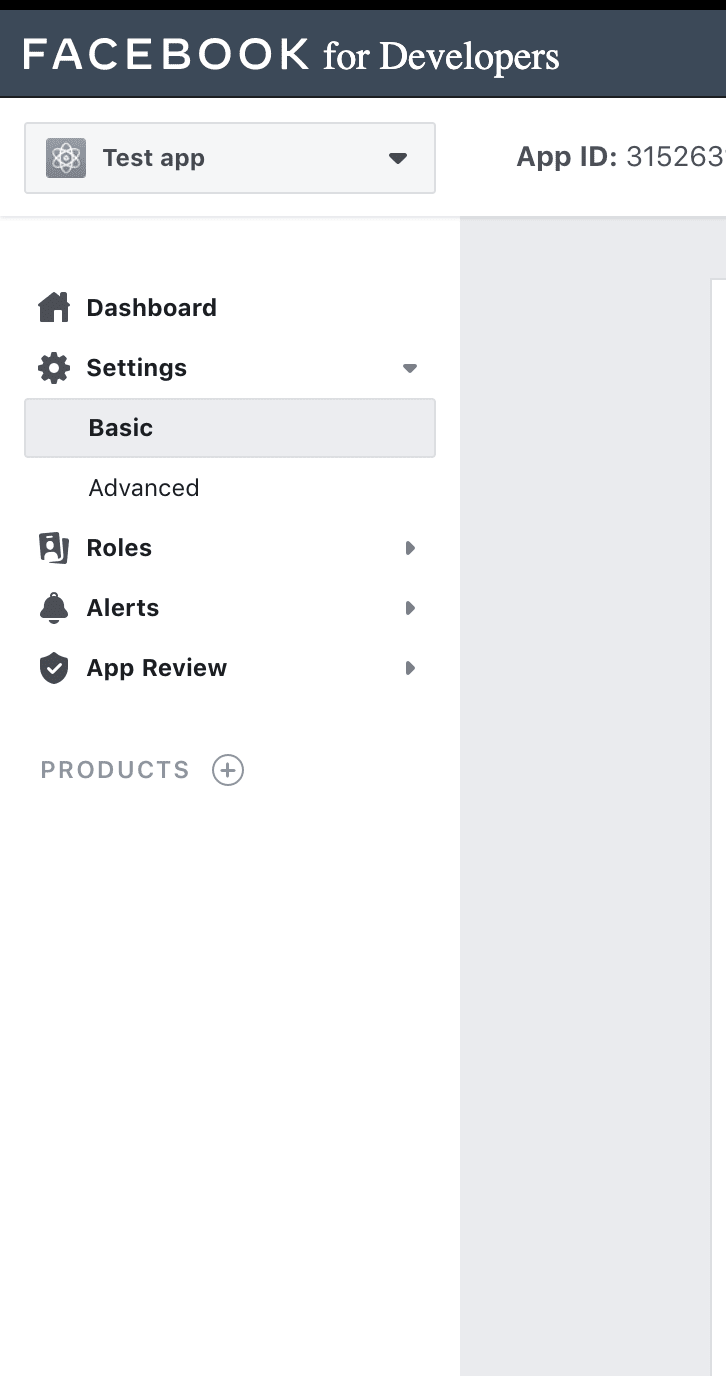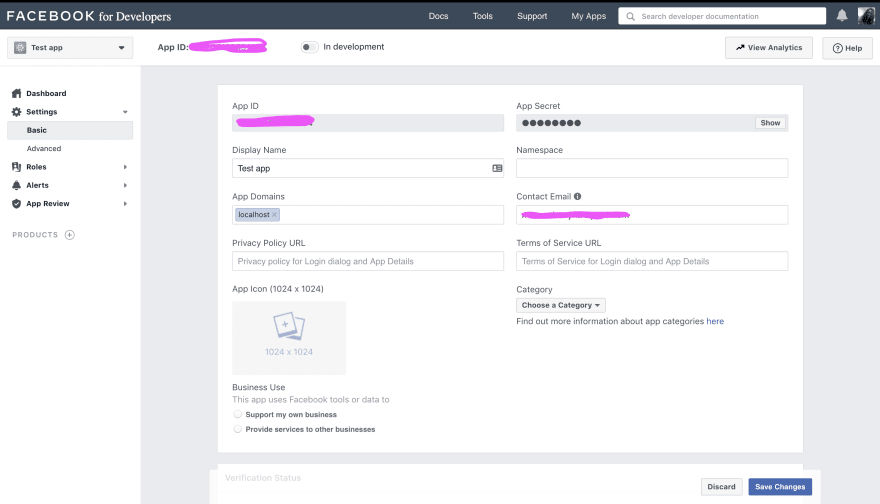Hello everyone,
This week, I will be writing about how to setup Facebook authentication for your Rails app.
Prerequisites
- An app using Rails 6 with devise setup for authentication
- A working knowledge of creating a new Rails app
- A working knowledge of devise for authentication
- An active Facebook account
Facebook Authentication
To implement Facebook auth, we need to create an app on Facebook that will generate an APP_ID and APP_SECRET for setting up devise omniauth later.
Create Facebook app
- Go to https://developers.facebook.com/
- Click on
My Appsin the navbar - Click on
Add a new App
- On the modal that pops up, select the
For Everything Elseoption.
- Next, add your
App Display Nameand click theCreate App Idbutton
- Complete the security check and this should redirect you to the app

- On the sidebar, click on
Settingand then click onBasic. You should be able to see yourAPP_IDandAPP_SECRET. Copy and save for later.
- In the
App domains, addlocalhost. You can also add your add icon if you have one.
- Scroll down to the end of the page and click on the
Add Platform
- On the modal that pops up, select
Website
- Add
http://localhost
- Save your changes
Setup Facebook Auth in devise
In this section, we will be setting up facebook auth in our rails app.
- Add the omniauth-facebook gem to your gemfile
gem 'omniauth-facebook'
- Run
bundle install - Next we create a migration to add provider and uid to the user model. This stores the provider the user uses to register whether its
facebookorgoogle.
$ rails g migration AddOmniauthToUsers provider:string uid:string
- Run
rake db:migrate - Next, we need to update the devise initializer file to include the
APP_IDandAPP_SECRETwe saved for later
# config/initializers/devise.rb
config.omniauth :facebook, "APP_ID", "APP_SECRET"
Note: If you chose to use the credentials to save your environment variables. You can use this command to edit it in your code editor. Run this code in your terminal. Change code part to your code editor if you don't use vscode.
$ `EDITOR="code --wait" bin/rails credentials:edit`
In the decrypted credential file, add the app_id and app_secret
facebook:
APP_ID: '<facebook_app_id>'
APP_SECRET: '<facebook_app_secret>'
So your initializer file update will be
config.omniauth :facebook, Rails.application.credentials.facebook[:APP_ID], Rails.application.credentials.facebook[:APP_SECRET], token_params: { parse: :json }
- Next we need to make the user model omniauthable. Add this to the user model
# app/models/user.rb
devise :omniauthable, omniauth_providers: %i[facebook]
- Next, we create an omniauth controller in a user folder to respond to facebook authentication.
# app/controllers/users/omniauth_callbacks_controller.rb
class Users::OmniauthCallbacksController < Devise::OmniauthCallbacksController
def facebook
@user = User.from_omniauth(request.env["omniauth.auth"])
if @user.persisted?
sign_in_and_redirect @user, event: :authentication #this will throw if @user is not activated
set_flash_message(:notice, :success, kind: "Facebook") if is_navigational_format?
else
session["devise.facebook_data"] = request.env["omniauth.auth"].except(:extra) # Removing extra as it can overflow some session stores
redirect_to new_user_registration_url
end
end
def failure
redirect_to root_path
end
end
- Next, we go back to the
usermodel to add thefrom_omniauthself method. This method finds or creates a new user when they register. The name_split part of for those that store the first_name and last_name of their users.
# app/models/user.rb
def self.from_omniauth(auth)
name_split = auth.info.name.split(" ")
user = User.where(email: auth.info.email).first
user ||= User.create!(provider: auth.provider, uid: auth.uid, last_name: name_split[0], first_name: name_split[1], email: auth.info.email, password: Devise.friendly_token[0, 20])
user
end
- Next, we update the routes file for include the new controller we just added
# config/routes.rb
devise_for :users, controllers: { omniauth_callbacks: 'users/omniauth_callbacks' }
- Finally, we add the facebook button to our view using a facebook path provided by devise. You can use this same path for both registration and login. You just need to update the button description.
<%= link_to "Register with Facebook", user_facebook_omniauth_authorize_path %>
And that should add facebook auth to your app.
Other Authentication
The process is quite similar for google authentication. We need to create a project for the app and then create the credentials for auth. I am going to attach a link to create credentials for google auth and the omniauth-google gem.
Create credentials on google
Omniauth Google gem
Omniauth twitter gem
Twitter guide for creating an app
Let me know what you think and what to write about in the comment section.
Until next week


















